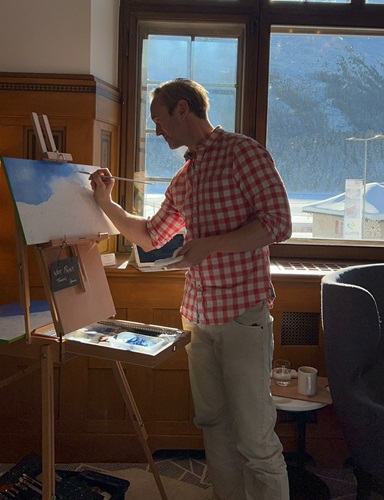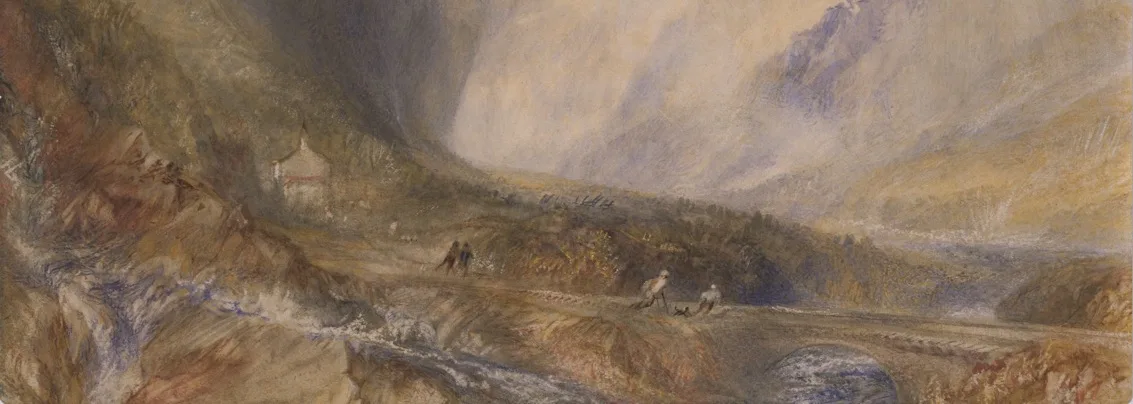Contemporary hyperrealist artist Adam Attew grew up in the Surrey Hills, known by the Victorians as “Little Switzerland” for its resemblance to the landscapes of the lower regions of the Alpine country and the purity of its air. He started to paint as early as he started to ski, at the age of two. He then combined both – mountains and canvases – in the late 1990s.
Attew spoke to our Editor-in-Chief, Julia Pasarón at the Hotel Grace La Margna in St. Moritz, where he was staying as Inaugural Artist in Residence, supporting the Swiss branch of the global non-profit organisation, Protect Our Winters.
He has been drawn to this part of the world – both in winter and summer – since he was a small child. Over the years, Attew saw first-hand the effect of global warming in these majestic mountains. “I’ve been coming to the Alps since the ‘70s,” he says. “I remember skiing on the glaciers of Chamonix, which used to cover an area much larger than they do now.” Attew is right. Global warming is having a catastrophic effect on the Alpine glaciers. Research shows that in the 20th century, the temperature in the Alps has risen by 2°C, at a rate of 0.5°C per decade since the 1980s. The consequences are disastrous, not only for the glaciers themselves but also for the species that have made these mountains their home. To give you an idea, for every increase of half a degree, wildlife must move 100m higher to find a cooler temperature.

The long, hot and dry summers of the late 1990s and the early 2000s saw Les Bossons (Mont-Blanc), one of the lowest-hanging glaciers in Europe, lose 20m in length and volume. Photo © Simo Räsänen.
Attew’s interest in painting mountain landscapes turned to the Alps in the early 2000s, exploring oils as the medium to represent them. “I had always been a little scared of oils but I soon fell in love with them, with their malleability and the endless possibilities they give to the artist,” he shares. Now, he uses nothing else.
For a long time, he had been toying with the idea of working with a charity or non-profit organisation. His environmental consciousness and love for the mountains drove him to approach Protect Our Winters Switzerland (POW). It focuses on four main fronts: on one side, mobility and nutrition (two of the sectors responsible for the highest emissions of CO2); and on the other, advocacy and education. At the heart of POW, there is a group of outdoor enthusiasts committed to protecting the precious winters that define the region’s allure. “After decades of enjoying them, I wanted to give something back to the Alps,” Attew says.

Adam Attew working on Last light on Kirchenkogel during his time at Grace La Margna. Oil on canvas. © Adam Attew.
At Grace La Margna, he made the main lounge (The Living Room) his atelier, which gave him the opportunity to talk to guests and spread the POW message. “I was surprised by the interest people have been showing,” Attew admits. “Some guests have come to speak to me more than once, genuinely interested, and are very pleased that part of the money they spend when purchasing one of my paintings is donated to POW.”
Climate change in the Alps doesn’t only affect the wildlife or the length of the ski season, but also the safety of the mountains. Attew warns, “The risk of avalanches is now so acute, that you don’t dare to go off-piste anywhere, unless it’s with someone who knows that specific location like the back of their hand.”
The fragility of this environment acts as further encouragement for Attew to capture its beauty. “It is getting harder and harder to find the pristine landscapes I like to paint,” he says. “For example, trees covered in snow; the chances to catch them get slimmer every year.”
“The hope is that, together with an appreciation of my paintings and of the beauty of the landscapes they feature, the viewer will feel the desire to protect them.”
– Adam Attew

Looking at his hyperrealist depictions of snow-capped peaks against intense blue skies, I understand why guests at the hotel engaged so much with him. Attew’s paintings literally stop you in your tracks, they are that impactful. His use of deep colours, contrasting textures and abstract contours result in spellbinding pieces of art that go far beyond what a camera could convey.
Having the chance to work and show his art at Grace La Margna has done wonders for POW’s exposure. “Most people I have spoken to here hadn’t heard of the organisation before,” Attew explains, “so I am very glad to be able to help.”
Credit is due to the hotel too. General Manager, David Frei, says, “Adam Attew’s art captures the beauty of the mountains that surround us very vividly; so, we knew that his presence at the hotel would engage our guests. We are also thrilled that through this partnership we can work with POW Switzerland to promote the great work it is doing.
“I feel motivated by the response I have seen during my time as artist in residence here at Grace La Margna.”
– Adam Attew

Attew is committed to his role as an agent for positive change. “I want to do more to help raise funds and awareness for POW,” he comments with conviction. “It’s not just the painting that I love, but also meeting so many people who appreciate the mountains.”
It has been enlightening to speak to Attew and learn about this innovative collaboration that will hopefully set a precedent for future initiatives at the intersection of art, hospitality and environmental responsibility.
www.adamattew.com
www.protectourwinters.ch
www.gracehotels.com
Opening image: Adam Attew, She Devil, 2020. Oil on canvas. © Adam Attew
Last image: Adam Attew, Magic in Leogang, 2019. Oil on canvas. © Adam Attew





























































